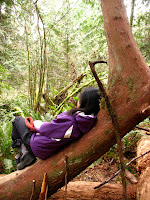 From the very beginning, their instructors helped us explore by engaging all of our senses and asking us questions to guide us to a deeper understanding. They taught us how to use owl eyes, fox feet, and deer ears in order to be aware of as much as possible around us. They encouraged us to slip off our shoes to truly feel the ground beneath us and walk even more silently, then, barefoot, we padded to find our own special place within the trees, a Sit Spot, from where we could observe the world around us. They took turns telling us the story of how Wilderness Awareness School came to be as we sat around a fire that had been started with a hand drill in a round hut called Malalo ya Chui, which means Lair of the Leopard. We learned bird language, experienced the WAS questioning approach, discussed edible plants, and tried our hand at a 2-match fire.
From the very beginning, their instructors helped us explore by engaging all of our senses and asking us questions to guide us to a deeper understanding. They taught us how to use owl eyes, fox feet, and deer ears in order to be aware of as much as possible around us. They encouraged us to slip off our shoes to truly feel the ground beneath us and walk even more silently, then, barefoot, we padded to find our own special place within the trees, a Sit Spot, from where we could observe the world around us. They took turns telling us the story of how Wilderness Awareness School came to be as we sat around a fire that had been started with a hand drill in a round hut called Malalo ya Chui, which means Lair of the Leopard. We learned bird language, experienced the WAS questioning approach, discussed edible plants, and tried our hand at a 2-match fire. We had a pasta potluck that evening, complete with stinging nettle tomato sauce, and chatted while passing around one of the WAS instructors baby, Wilder. After dinner, we played games of stealth in front of the blazing wood stove, then a small group of us hiked through the darkness down to the pond to star gaze.
We had a pasta potluck that evening, complete with stinging nettle tomato sauce, and chatted while passing around one of the WAS instructors baby, Wilder. After dinner, we played games of stealth in front of the blazing wood stove, then a small group of us hiked through the darkness down to the pond to star gaze. After a night spent shivering in my sleeping bag in below freezing temperatures, a cup of coffee and my enthusiasm to learn more about WAS's programming gave me energy to face the new day. Between sips of freshly brewed hemlock tea, a group of us learned how to make bow drill sets and sat whittling away around a fire until we all had our very own bow drill kits to bring home. While we made our kits, other groups tracked cougars, followed the beat of a drum blindfolded through the forest on a Drum Stalk, and explored the rest of WAS's land, called Linne Doran, meaning Pond of the Otter.
After a night spent shivering in my sleeping bag in below freezing temperatures, a cup of coffee and my enthusiasm to learn more about WAS's programming gave me energy to face the new day. Between sips of freshly brewed hemlock tea, a group of us learned how to make bow drill sets and sat whittling away around a fire until we all had our very own bow drill kits to bring home. While we made our kits, other groups tracked cougars, followed the beat of a drum blindfolded through the forest on a Drum Stalk, and explored the rest of WAS's land, called Linne Doran, meaning Pond of the Otter. When all the groups finished, we came together to try making a coal using a giant bow drill kit. The drill was about 3 feet tall, so it took a lot of us to pull the rope wrapped around it back and forth to get the base board hot enough to form a coal. But we did it, and it was sure a sense of accomplishment! Before leaving, we had an enlightening conversation about the natural directions and the indicators of awareness within teaching. They're hard to explain, but in brief, they are part of an educational theory that is based on the natural tendencies of humans over the course of a day and the course of a program, including energy levels and times for reflection. I found a lot of truth in the theory and you can learn more about it in Coyote's Guide to Connecting with Nature, the book on everything WAS.
It was an incredible weekend and all of the IslandWood instructors who attended picked up new approaches to teaching that we have been weaving into our School Overnight Program lessons. I personally have started doing Sit Spots, animal senses, bird language, and a story of the day with my students, all of which I learned more about at WAS. The instructors from NCI, IslandWood, and WAS also formed a warm supportive community, the ties of which will hopefully hold strong into the future.




